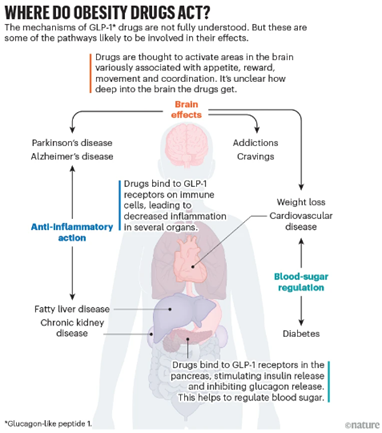Weight Loss Drugs - The Cure to Everything???

Obesity is currently one of the biggest global health issues of today – classified as a ‘global epidemic’ by the WHO, about 1 in 8 people are obese worldwide. Associated with both physical and mental complications, obesity can increase the risk of type 2 diabetes and cardiovascular disease, whilst carrying also a social stigma which could lead to low self esteem or even depression. Although it is a heavy topic to discuss, the development of weight-loss drugs in recent years have given us a strong edge in the battle against obesity: GLP-1 agonists specifically have become very popular recently, in the form of trademarked drugs such as Ozempic or Wegovy. As it turns out, GLP-1 agonists are involved in more physiological mechanisms than just obesity, and have the potential to cure… everything?
A brief history of GLP-1 agonists

The origins of GLP-1 agonists can be traced back to the summer of 1980, during the study of the surprisingly cute Gila monster. Growing up to 56 cm in length, the Gila monster is a venomous reptile found mainly in the US and Mexico. Intriguingly, the Gila monster only needs to eat once or twice a year – this prompted researcher Jean Pierre Raufman to study the Gila monster’s venom, where he discovered the exendin-4 peptide which had an amino acid sequence remarkably similar to that of GLP-1.
GLP-1, which stands for glucagon like peptide 1, is a hormone which is found occuring naturally in the gut after consuming food. It reduces gastric emptying and stimulates insulin production, which reduces appetite and promotes the storage of glucose as glycogen. It’s potential to treat type 2 diabetes was recognised, due to its ability to reduce glucose concentration in the blood. However, the half-life of naturally occuring GLP-1 is 2 minutes, making GLP-1 drugs very impractical since they have to be administered via injection.
The exendin-4 peptide discovered by Raufman was the perfect candidate to act as a substitute for GLP-1, since it had a much longer half-life whilst causing the same response as GLP-1 – the current dose for Ozempic is once a week. Exendin-4 was soon patented in 1993 as a commercial drug, marketed as a treatment for type 2 diabetes. Since then, the family of GLP-1 agonists (drugs which mimic the action of GLP-1) has grown into a global industry. Just last year, the production of the GLP-1 agonist semaglutide (as found in Ozempic) turned the pharmaceutical company Novo Nordisk into the most valuable company in Europe in 2024. With a projected $100 billion revenue by 2030, GLP-1 agonists are poised to make a significant impact in the near future and have come far from its humble beginnings.
The main uses of GLP-1
In biology, an agonist is a substance which mimics the function of a biological molecule such as a hormone or neurotransmitter, by binding to the intended receptor and eliciting a similar response. GLP-1 agonists are therefore a family of drugs which mimic the action of GLP-1. However, they have the added benefit of a greater uptime, thanks to the improved half-life of about 7 days. Thanks to this, scientists have found that the extended circulation of GLP-1 agonists in the bloodstream brings far more benefits than first imagined. Below is an extensive (but by no means exhaustive) list of increasingly obscure benefits of GLP-1 agonists:

Type 2 diabetes
Type 2 diabetes is a disease where insulin sensitivity and production is decreased. This means that after a meal is taken, the glucose is unable to be stored as glycogen within the liver/skeletal muscle cells and remains circulating in the blood, which leads to a variety of complications. GLP-1 agonists can reduce the blood glucose concentration mainly through inhibiting glucagon, the hormone which promotes glucose release, and producing insulin, the hormone which promotes glucose storage. Although this doesn’t address the main issue of insulin resistance, the high amount of insulin produced helps provide a temporary solution to any complications caused by hyperglycaemia.
Obesity
Another main benefit of GLP-1 agonists is that of weight loss, as they also have the function of reducing gastric emptying and affecting appetite control in the brain. GLP-1 receptors are also found in various parts of the brain, including the hypothalamus and the hindbrain which regulate hunger and cravings. While the mechanism of how the GLP-1 agonists are able to penetrate so deeply into the brain despite its many safety barriers are still unclear, the evidence strongly shows that the agonists are able to somehow influence appetite through the receptors deep within the brain, hence inducing weight loss by reducing the consumption of food over a long period of time.
Penetrating the brain – addictions and mood control
GLP-1 agonists also have a far and widespread influence over the neurones in the brain, as researchers are beginning to realise. They involve reward circuits, as well as mood control. Recently, the ability of GLP-1 agonists to reduce addictions and cravings has been of particular interest to scientists. This ranges from alcohol and tobacco to cannabis and opiod use – it seems like the ability of GLP-1 agonists to reduce addictions is pretty universal, and it is currently undergoing trials to test for its viability in medical use.
As mentioned earlier, the ability to control mood has opened doors for the potential use of GLP-1 agonists in treating depression and suicidal ideation. Like many antidepressants, GLP-1 is able to target neurotransmitters such as serotonin. This allows the drug to reduce symptoms such as anhedonia (which is the loss of pleasure) often noted in depressed patients.
Inflammation
Inflammation occurs when large amounts of immune cells rush to a site of infection or injury to help kill any potential foreign pathogens. However, over long periods of time chronic inflammation can lead to diseases and cancers. Inflammation is characteristic of non-alcoholic fatty liver disease (NAFLD), which is when the liver accumulates damage due to excessive fat buildup. In animal trials, GLP-1 has been found to reduce inflammatory effects when binding to GLP-1 receptors in sites such as the kidneys, liver and heart. Because of this, GLP-1 agonists are currently being studied as a potential NAFLD treatment.
Inflammation is also common in neurodegenerative diseases such as Parkinson’s or Alzheimer’s. GLP-1 agonists have been shown to significantly increase motor ability in Parkinson’s patients, and reduce cognitive decline in patients with Alzheimer’s. Trials are currently taking place to test its medical viability, led by institutions such as UCL and Novo Nordisk.

... There's more?
It doesn’t stop there - GLP-1 agonists have shown promise in the treatment of cardiovascular disease, male/female infertility, sleep apnea, polycystic ovary syndrome, and reducing the risk of various cancers including esophageal, colorectal, pancreatic, kidney and more. The unexpectedly widespread range of influence GLP-1 agonists demonstrated have taken both researchers and investors by storm, as it becomes without doubt one of the most promising emerging drugs in recent years.
So, what's the catch?
In terms of side effects, GLP-1 agonists are fairly safe, only causing vomiting, nausea or diarrhea in uncommon cases. They are also contraindicated in patients with risk of pancreatitis or cancers of the pancreas, thyroid or endocrine system. The main drawback of GLP-1 agonists, however, is arguably its cost. GLP-1 agonists are more expensive compared to more commonplace type 2 diabetes treatments – in the US a monthly dose of Wegovy could cost up to $2000 USD. Considering that the drug must be taken over a long period of at least a year to take effect, and that they are not covered by health insurance when used for weight loss, it takes a serious economic toll on those who may not able to afford a healthier lifestyle or diet in the first place
In conclusion, GLP-1 agonists are an exciting family of new drugs with vast potential to treat a large variety of diseases, most notably type 2 diabetes and obesity which currently affect a significant proportion of the global population. There are still many barriers for GLP-1 agonists to overcome, including the uncertainty of how it affects health in the long term, as well as legal barriers to development, such as the current US health secretary candidate RFK Jr being an outspoken critic of the drug. One thing is for certain, however – with the relevance of these emerging treatments steadily increasing, GLP-1 agonists are sure to make a significant contribution to the future of healthcare.
